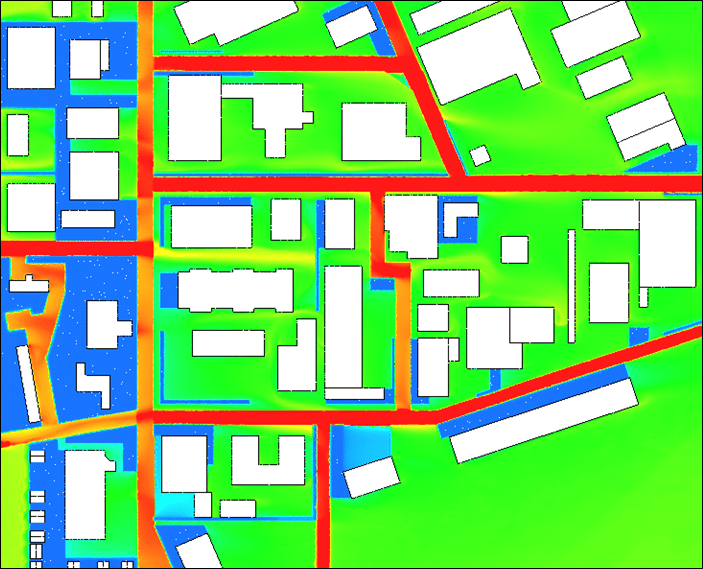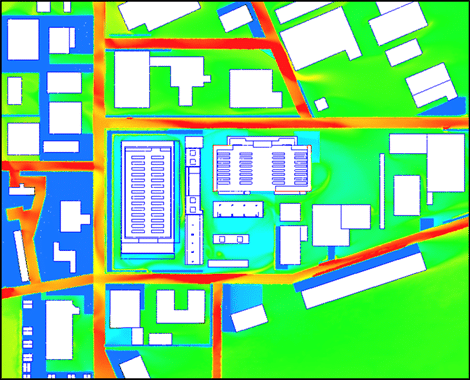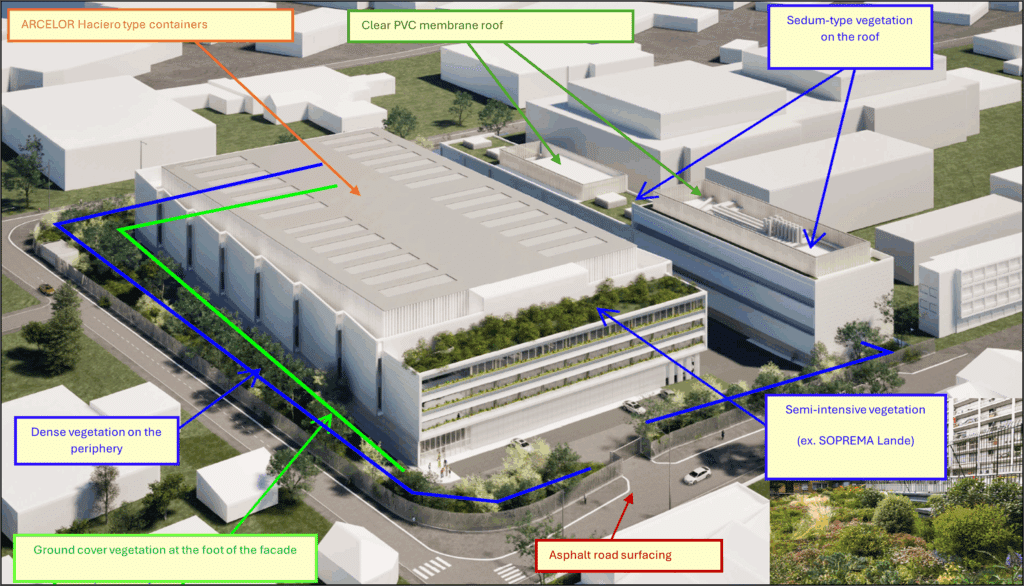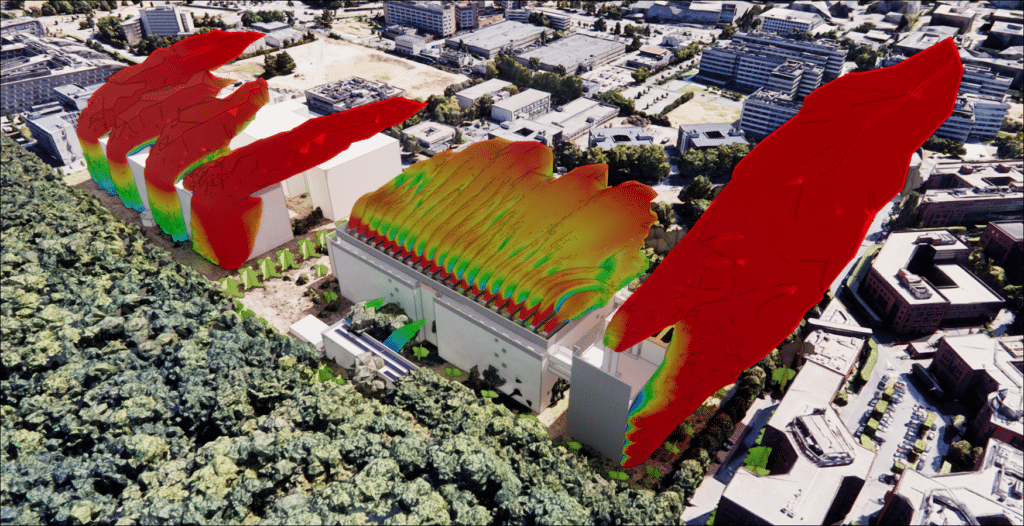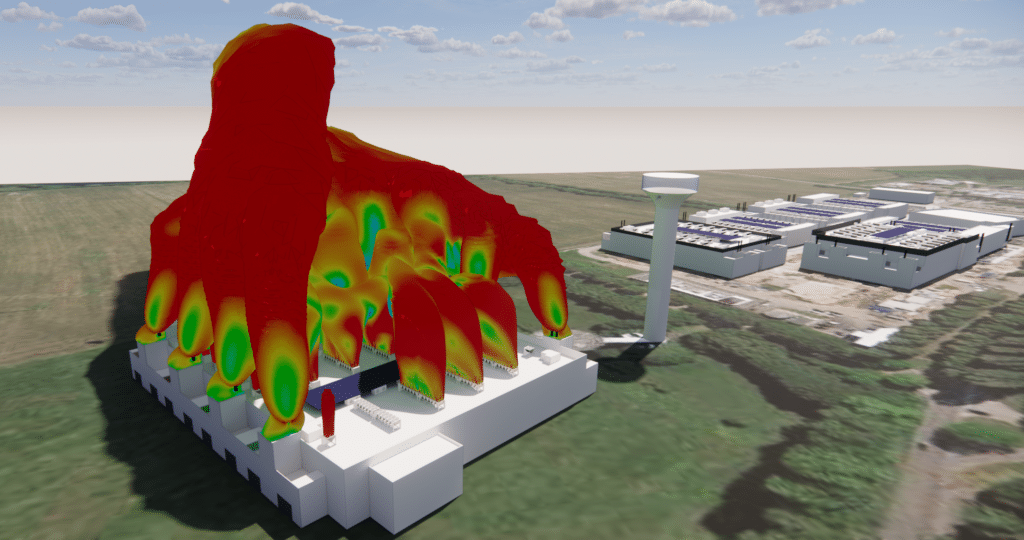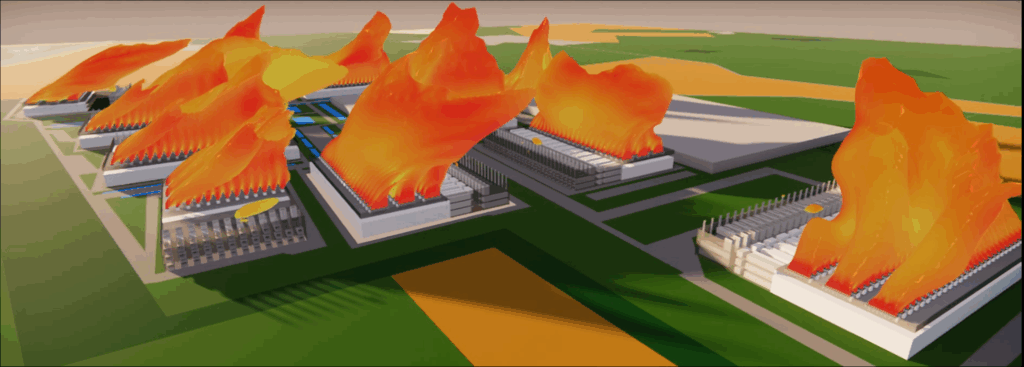Urban heat island impact study for data centers
Study of the impact of heat islands formed by data centers
We are experts in CFD analysis and assessment of the environmental impact of data centers in their urban context.
- Identifying heat islands generated by digital infrastructures
- Thermal impact assessment under real-life weather conditions
- Analysis of the interaction between thermal discharge, urban morphology and natural ventilation conditions
- Study of the cumulative effects of several heat sources in the same district (data centers, source stations, substations, etc.).
- Simulation of thermal dispersion according to different layout and operating scenarios
- Comparison of mitigation solutions (greening, ventilated facades, heat recovery, etc.)
- Decision support for development projects and the design of responsible digital infrastructures
Characterization of heat islands induced by data centers
Origin and intensity of thermal emissions
The urban heat island effect is the temperature gap observed between a city and its surrounding rural areas. Building materials, dense urbanization and lack of vegetation trap heat, creating the ” heat bubble ” typical of city centers.
Datacenters, with their large-scale thermal waste, are part of this anthropogenic heat input. This waste heat, if not recovered and reused, contributes to the urban heat island effect. In other words, not only does it
Mapping thermal influence zones
The CFD simulation tools developed by EOLIOS enable detailed characterization of the heat plumes emitted by data centers, taking into account site specificities (geometry, topography, layout) and actual environmental conditions (prevailing winds, solar orientation, humidity, etc.).
These 3D aeraulic models accurately reproduce the propagation of hot exhaust air, its gradual dilution in the atmosphere and its interactions with elements of the urban fabric (facades, streets, trees, roofs, etc.).
Based on several studies carried out by EOLIOS, the thermal range of a plume can extend up to 150 m at low wind speeds. These visualizations, rendered in the form of dynamic thermal maps, enable designers and town planners to better anticipate the intersecting effects between digital infrastructures and the urban environment.
Mapping temperatures at 1 m above ground before (left) and after (right) - Study of data center heat island effects
Analysis of seasonal and hourly variability
The thermal effect induced by data centers is not constant throughout the year. It varies according to a number of factors: IT power consumption, chiller operating mode, external weather conditions (temperature, humidity, wind direction and speed), as well as the density of the urban environment. In summer, periods of high heat coupled with stagnant air can lead to significant heat build-up, particularly at the end of the day or during the night, when hot emissions are no longer efficiently dispersed.
The CFD simulations carried out by EOLIOS take this variability into account by modeling different seasonal and hourly scenarios (typical hot day, off-season, calm night with no wind…). This dynamic approach makes it possible toidentify the most critical periods for urban comfort, and to quantify the thermal differences according to the thermal discharge management strategies.
Urban integration studies for thermal discharge equipment
Orientation and layout of equipment
The position, orientation and layout of thermal rejection systems – such as dry coolers, condensers or cooling towers –play a decisive role in the diffusion of waste heat into the urban environment. Incorrect siting can accentuate urban heat island (UHI) effects, disrupt outdoor thermal comfort, or lead to recirculation of warm air into fresh air intakes.
The materials used in the construction of buildings play a decisive role in the intensity of urban heat islands. Concrete, asphalt, dark tiles and metal cladding all share a strong capacity to store solar heat during the day and release it slowly at night. This phenomenon ofthermal inertia contributes to maintaining high temperatures in urban environments, even in the absence ofdirect sunlight.
The CFD simulation tools used by EOLIOS enablea comparative assessment of several siting configurations (height, orientation, distance between units, close masks), under realistic climatic conditions, including the site’s annual wind rose and solar radiation.
Calculating the height and shape of thermal plumes
The shape and vertical extension of the hot air plumes generated by the equipment depend on a number of parameters: supply temperature, discharge speed, size of extract units, atmospheric turbulence, thermal stability of the ambient air, and so on.
CFD simulations carried out by EOLIOS make it possible to visualize plumes in three dimensions, assess their range in time and space, anddetermine their impact on sensitive areas.
Based on the results, we propose architectural or technical adjustments, such as raising the height of the equipment, adding deflectors, or integrating plant screens to promote thermal dispersion and limit recirculation effects. These measures can reduce local thermal impact by 30 to 60%, depending on the context.
Data center temperature isosurfaces
Interaction with surrounding buildings in urban environments
Thedense urban environment often acts as a thermal trap, limiting heat dispersion and encouraging recirculation to neighboring facades and air intakes. Our CFD analyses highlight the hot flows that can reach openings, glazings sensitive to overheating, or air inlets of neighboring AHUs.
Our recommendations are part of a global approach to environmental optimization, in line with the requirements of urban planning documents, HQE/BREEAM standards, or recommendations stemming from the Territorial Climate Air Energy Plan (PCAET). Theyensure that the energy performance of digital infrastructures and the quality of urban life coexist in a sustainable way.
Thermal impact mitigation solutions
Improving discharge performance
The thermal impact of cooling plants can be significantly reduced by a combination of technological choices, operational optimization and aeraulic design. At EOLIOS, our studies use high-precision CFD simulations to evaluate and compare the effectiveness of various thermal mitigation strategies in an urban context.
The type of discharge equipment plays a key role: variable-speed air coolers, for example, enable dynamic adaptation to climatic conditions, reducing unnecessary heat rejection during periods of low thermal load. Theaddition of flow-guiding devices, such as deflectors or windbreaks, also helps to channel heat rejects towards less sensitive areas. In addition, passive solutions such as thermal silencers or heat dissipation grilles encourage faster mixing with ambient air, locally lowering perceived temperatures by an average of 1 to 2°C at a distance of 5 meters.
All these approaches are evaluated by EOLIOS on a case-by-case basis, using numerical simulations incorporating actual climatic conditions (wind, radiation, temperature), site geometry and equipment operating cycles. These analyses enable us to prioritize action levers according to their effectiveness, cost and compatibility with the site’s operational constraints.
Our recommendations are always contextualized within a global performance approach, integrating PUE limitation, user comfort and local regulatory requirements.
Thermal impact mitigation solutions
Compliance with environmental requirements
Against a backdrop of tightening regulations linked to the ecological transition, datacenters are increasingly subject to requirements in terms of energy performance, landscape integration and air quality. In particular, the European Energy Efficiency Directive requires member states to step up energy monitoring of datacenters over 500 kW from 2024, including annual reporting on exhaust air temperature, the rate of use of waste heat and PUE.
The CFD studies carried out by EOLIOS enable us toanticipate these requirements by accurately modeling thermal plumes and their diffusion in the urban environment, while identifying sensitive points. Our simulations can incorporate projected climate evolution scenarios (RCP 4.5 or 8.5), to guarantee the compliance of installations in the medium and long term, taking into account the expected increase in average temperatures and extreme phenomena (heat waves, lack of wind, etc.).
In the Île-de-France region, for example, datacenter projects are increasingly being assessed against the objectives of the regional climate plan (SRCAE), which sets a target of halving the energy consumption of tertiary buildings by 2050. Our studies are part of this dynamic, providing project owners with deliverables that can be used in applications for building permits, impact studies, or HQE, BREEAM or ISO 50001 certification.
Support for consultation with local residents
The urban integration of a data center is not just a technical issue: it’s also a social and territorial one. The perception of thermal pollution, although sometimes invisible to the naked eye, can be a source of concern for local residents. That’s why EOLIOS has developed easy-to-read thermal maps, 3D plume animations and visual summaries for public presentations and consultation workshops.
Study of heat emissions from data centers in urban environments
These tools make it possible to translate the potential impact of the project on its immediate surroundings into concrete elements: local rise in temperature, altered wind speed, heating of sensitive facades, etc. Thanks to synthetic indicators (temperature differences at 1.5 m above ground level, frequency with which comfort thresholds are exceeded according to EN ISO 7730, etc.), our studies help to objectify debates and reassure stakeholders.
Towards more responsible data centers
Reducing thermal discharge into the environment is not just a matter of complying with regulatory requirements: it also means choosing a more virtuous infrastructure, in line with social and environmental expectations. In a city like Paris, where the urban heat island effect can increase the average temperature by +2 to +3°C in summer, limiting additional heat input is a major challenge for the comfort of residents and climate resilience.
EOLIOS supports its customers in their efforts to recover energy from waste, through the design ofhybrid solutions incorporating vegetation, passive cooling and architectural integration. This global approach positions data centers not simply as energy consumers, but as responsible players in the sustainable city.
EOLIOS, your partner for the sustainable integration of data centers in cities
Faced with the growing challenges of energy efficiency, urban comfort and environmental regulations, EOLIOS can help you design and operate data centers that are perfectly integrated into their environment.
Thanks to our state-of-the-art CFD simulation tools and our recognized expertise in thermal and aeraulic modeling, we are involved at every stage of the project:design, sizing, impact analysis and regulatory support.
- A tailor-made approach for each site, taking into account local climatic conditions, surrounding urban planning and technical specifications.
- Concrete solutions for sustainably reducing heat nuisance and improving PUE.
Contact us today to assess the thermal impact of your facilities, anticipate regulatory requirements and identify the best mitigation strategies. Together, let’s make data centers a lever for a more sustainable city.
Find out more:
Our specific solutions for data centers :

CFD engineering for data centers
Find out more

Thermal storage study
Find out more
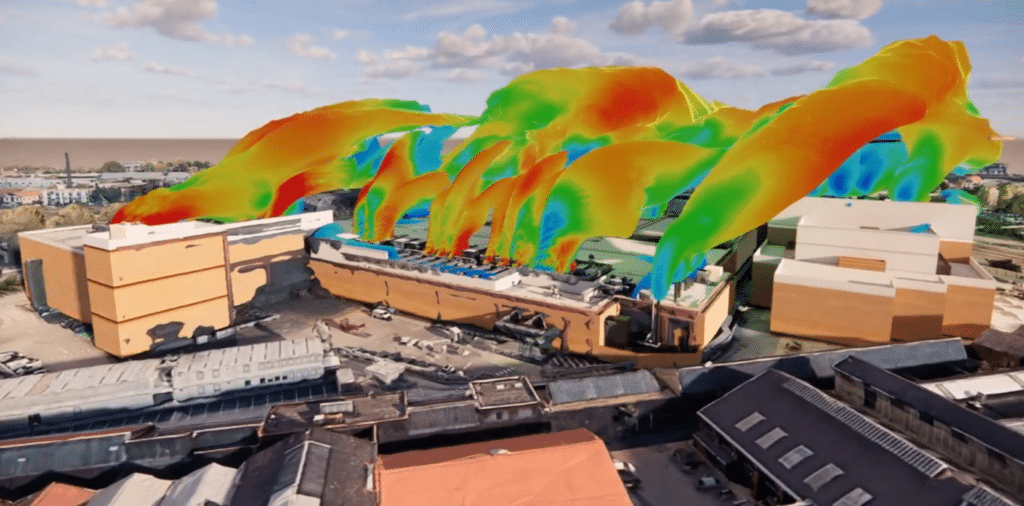
External CFD simulation for data center
Find out more

Data Center Fire Simulation
Find out more

Thermal study of technical premises
Find out more
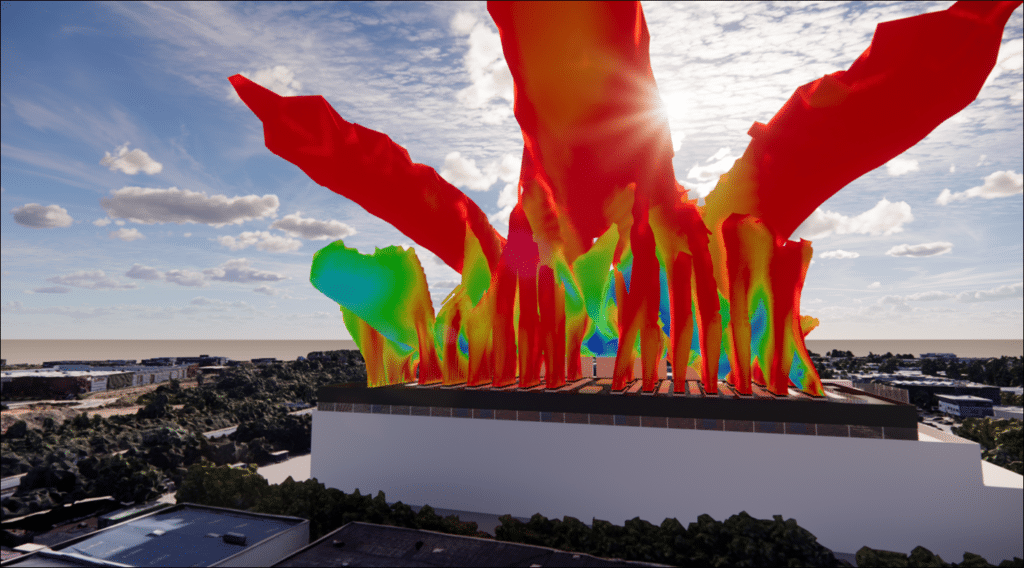
Urban heat island impact study for data centers
Find out more

Audit, diagnosis and 3D modeling of existing data centers
Find out more
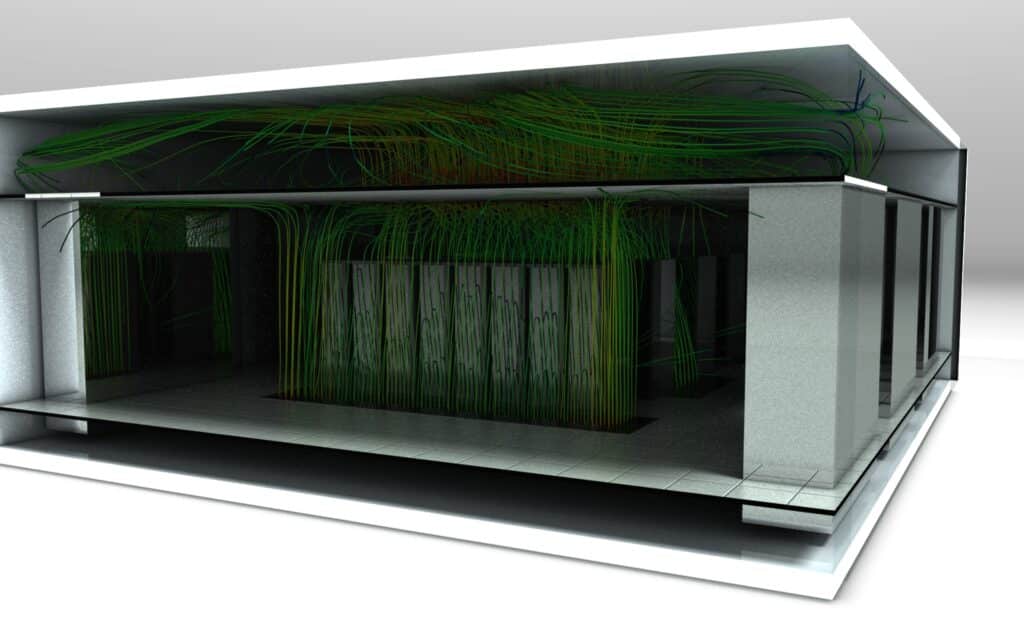
Designing your data center’s digital twin
Find out more
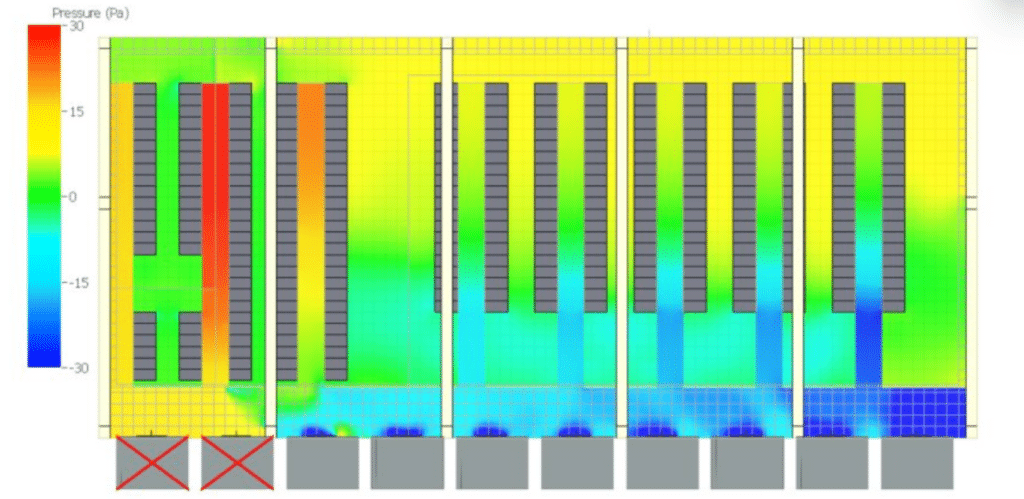
Energy optimization and PUE calculation for data centers
Find out more

Commissioning: study and CFD modeling of load benches
Find out more
Data center engineering
Initially created in France, EOLIOS Ingénierie is the benchmark thermal and aeraulic simulation consultancy for data centers in Europe and worldwide. The company supports operators, designers and project owners at every stage in the life of a data center: design, optimization, renovation or extension.
By combining cutting-edge scientific expertise, state-of-the-art simulation tools and in-depth knowledge of the data center ecosystem, EOLIOS Ingénierie is a trusted partner for ensuring the availability, security and energy performance of IT infrastructures, while anticipating sustainability issues.
EOLIOS
PARIS – LONDON – MILAN – MUNICH – MADRID – WARSAW – CASABLANCA – UNITED ARAB EMIRATES – USA

